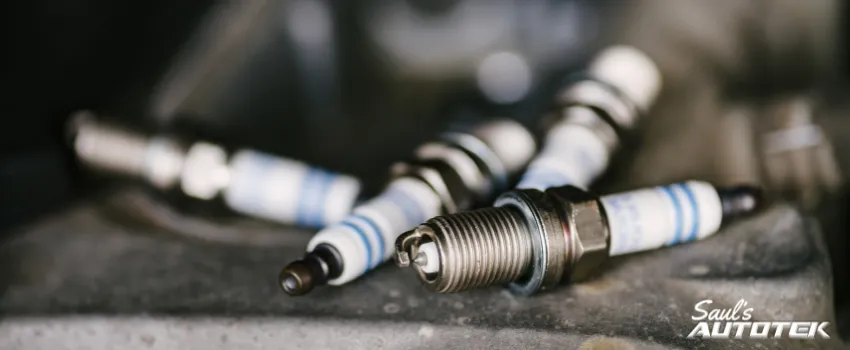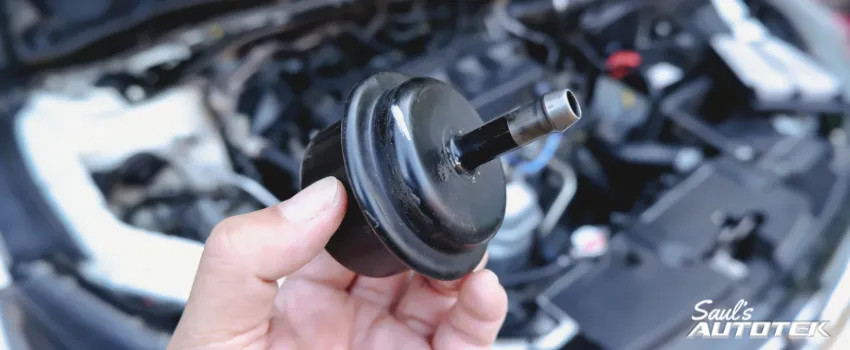Good morning. I’m Saul Reisman, owner of Saul’s Automotive, an Greenwood Village, Colorado, auto repair shop. Today we’re going to be taking a look at a 2001 Jeep Wrangler that recently came into us with the complaint that the vehicle would only move in four-wheel drive.
Under regular two-wheel-drive operation, the engine would simply rev, and the vehicle would go nowhere in place. The owner stipulated that they’d heard some noise from the rear of the vehicle, continued to operate it until that noise got louder and louder, and then that noise stopped, and the vehicle would only move forward in that four-wheel progress.
When they came into us, the rear axle itself was almost completely destroyed. Now, in the rear axle of this vehicle, power enters the differential through this pinion gear. The drive shaft of the vehicle spins this gear, which then engages a rotating gear, also known as the ring gear, to spin the axle shafts to both sides. We effectively name these the ring and pinion gears. These gears are physically what’s turning to put the power to the pavement every time you step on the gas. In the majority of pickups, SUVs sold in America, the rear axle of your vehicle looks exactly like this.
We’ve already gone ahead and replaced the pinion gear in this vehicle, but we’re going to show you exactly what came out of here so that we can hopefully stop these failures a little sooner. When Jeep produced this vehicle, they optioned two different rear axles. This was the lesser strength of the two. In this case, we’re going to be replacing it with that stronger Dana 44 axle upgrade. Let’s take a look at what we pulled out of this guy. Now, this is the pinion gear as an assembly, where the drive shaft bolts to it and attaches to where we see it spinning through the differential.
Now, the first difference we’ll see, first the one that’s in the vehicle — there’s no teeth left on this. Literally every tooth has been completely chewed and destroyed. Now, the reason that this happens is the pinion itself is set in place with two bearings to allow it to spin. Just like my hand is gripping it, the two bearings would sit on it to allow it to spin in a nice, tight circular pattern. That pinion bearing started to fail, which is relatively common in all motor vehicles. When that pinion bearing failed, rather than this pinion spinning in a perfectly true and straight line, it allowed this pinion to walk up and down so that the gears that were striking it were no longer getting a consistent mesh where they were engaging.
We’re going to take a look at the gears that we pulled out of this vehicle. Now, this is the ring gear that we removed. We can see that there’s chips into the teeth themselves, and there’s markings along the gear facing. We can also see that the teeth are actually flattened out and have started to break down because of the poor contact they’ve had with this pinion gear. What we would typically look for is a smooth engagement. At this point, literally has no motion of engagement. Now, this repair should’ve been caught early. Could have been a noise from the rear axle, and the vehicle would have come in, simply had this one bearing replaced, resealed, filled back up with fluid. A very inexpensive repair.
However, in situations like this, where vehicles are driven to the point of failure, that can truly drive the cost up tremendously. While this may have been a $200 to $300 repair to simply replace the pinion bearing, as of this point, this bearing got so bad, it allowed the pinion gear to be eaten up and the ring gear to be eaten up. Additionally, where the actual rotating assembly of this carrier spins inside the axle itself, it destroyed both these outer bearings that allowed this differential to rotate. As a result, the actual housing itself suffered damage, and we had to machine the actual housing so that we could fit a new differential into it.
We were fortunate that we were able to do such at that, because if not machinable, the entire axle assembly would have to be replaced at a cost of several thousand dollars. From our perspective, we’ll be able to completely rebuild this axle with bigger and stronger components. One aspect we’re going to look at while we’ve got this guy apart is the open differential. We’re going to pull all our hardware out of this guy so that we can spin this up and show you exactly what we mean here. When we look inside the opening of this differential, we get to learn the true meaning of the word “differentiate.” Now, the ring gear will bolt to this outer portion to rotate this entire housing. As a result, the two axle shafts that press through the sides where my thumbs are going here should rotate with this carrier.
However, physics tells us that torque will take the path of least resistance. In the event that these gears rotate, they will actually ratchet and let the differential spin freely. Even if an axle shaft is bound to this gear and an axle shaft is bound to this gear, if one tire were to break free and spin loose, as in on wet pavement, the outer tire that has the least resistance would continue to spin. The definition of this differential is it allows this gear set to differentiate that torque path. While that is beneficial by providing a smooth consistent ride on the road, this means that only one of the two tires in the rear of the vehicle is actually receiving power.
Now, 99 percent of the time, this isn’t a problem. In Colorado, where we have wet and snowy roads for half the year, this is a major problem. As part of the rebuild we’re going to be doing, we’re going to be replacing this carrier with a locking differential. Now in this case, what that means is inside this gear set, there will actually be a spring-loaded clutch that will sit internally and push outwards in both directions. What this will do is effectively bind these two side gears or spider gears to each other at all times. That’ll transfer power to both rear tires — 50 percent, 50 percent — all the time.
The reason that we use a spring clutch inside it rather than a truly locked differential is that in the event the vehicle makes a corner at high speed, that outer tire must travel a greater distance than the inner tire. It must physically rotate faster. If the two axle shafts are bound to each other completely, that would translate to a slipping or sliding vehicle and not a smooth, comfortable or safe ride. In order to get you the most traction but still keep you as safe as possible, we’ll be installing this spring clutch limited slip.
That’ll allow the vehicle to put power to the pavement and, at the same time, when it comes around a corner and steps on the gas, will still allow the differential to open and act smoothly and predictably to help keep you on the road.
If you have a Jeep, pickup, SUV or any off-road toy and you’re looking at having your axle or bearings rebuilt, here at Saul’s Automotive, not only do we service and rebuild differentials, we can upgrade, replace, lock, actuate and physically change every aspect of the way your axle operates. Please give us a call here at Saul’s Automotive. We can be reached seven days a week at 303-919-7769. Thank you.
Schedule Your FREE diagnostic Subaru Outback Auto Repair Upkeep and Repair Appointment
Check out Our Reviews On Yelp! And Leave A Great One For Us!
Join Our Conversation on Facebook
Explore Our Exceptional Denver Auto Repair Services
- Brake Repair Service
- Suspension Repair
- Steering Repair
- Engine Repair
- Automotive Air Conditioning and Heating Repair





